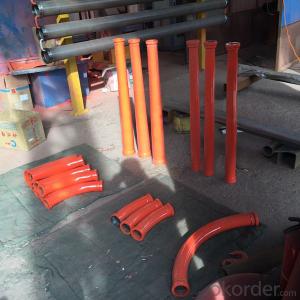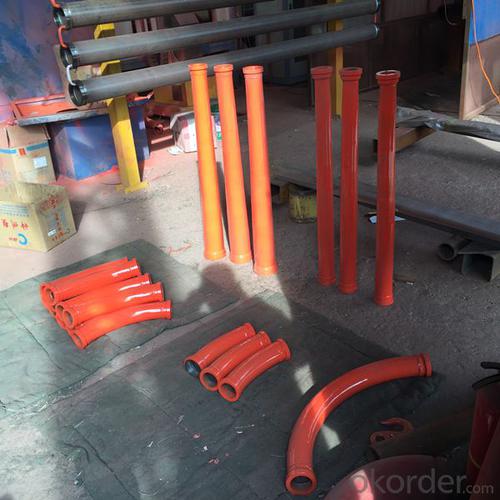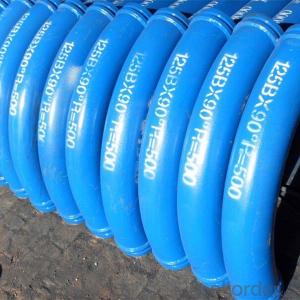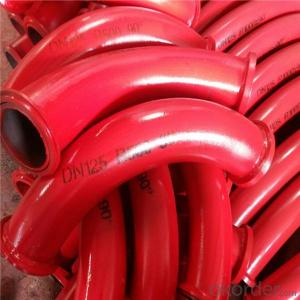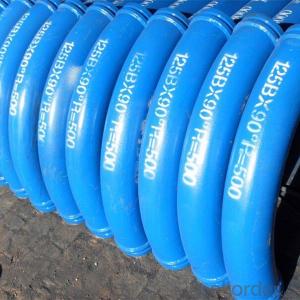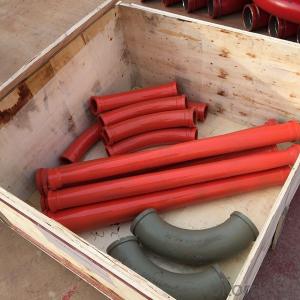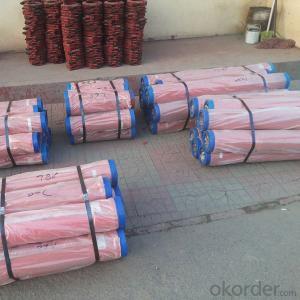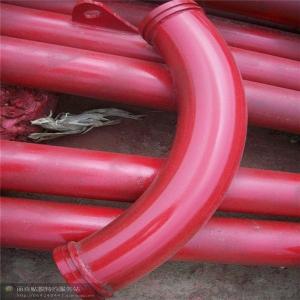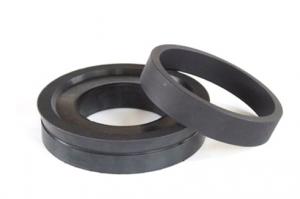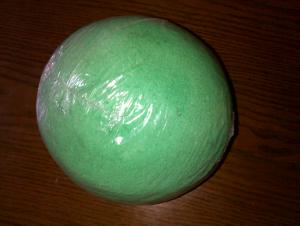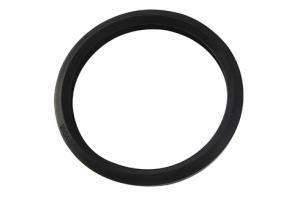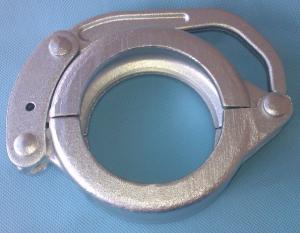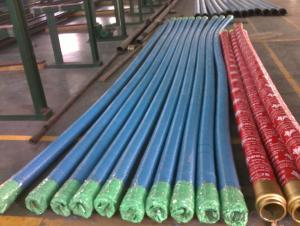Concrete Pump Spare Parts Delivery Bend 45 Degree
- Loading Port:
- Tianjin
- Payment Terms:
- TT OR LC
- Min Order Qty:
- 20 pc
- Supply Capability:
- 2000 pc/month
OKorder Service Pledge
OKorder Financial Service
You Might Also Like
Concrete Pump Spare Parts Delivery Bend 45 Degree
1. Structure of Concrete Pump Spare Parts Delivery Bend 45 Degree:
Concrete Pump Spare Parts Delivery Bend 45 Degree is used on concrete pump pipeline for concrete delivery which is much bigger than concrete elbows. It is made by St52 seamless pipe. Now its main structure is as follows;
Material: ST52, 45Mn2 etc.
Flange: ZX, F/M elbow
Size: DN125 etc.
Working Capacity: 25000-45000cbm
Degree: 90, 60, 45, 30 etc.
2. Main Features of Concrete Pump Spare Parts Delivery Bend 45 Degree:
• High Wear-resistant, long service life, lower cost
• In case of quality problem the company provide free replacement.
• Provide technical support for free.
• Provide consumers with regular visits
• Ensure the supply of ancillary parts
• Our company passed the ISO9000 certification, the product through 3C certification in full compliance with national standards.
3. Concrete Pump Spare Parts Delivery Bend 45 Degree Images:
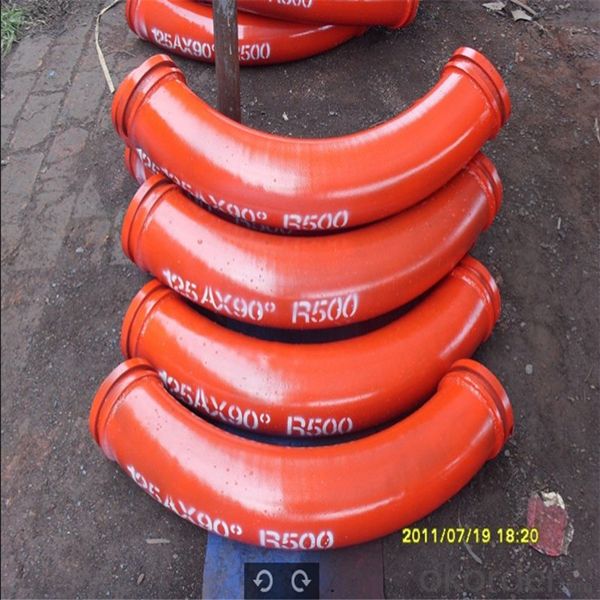
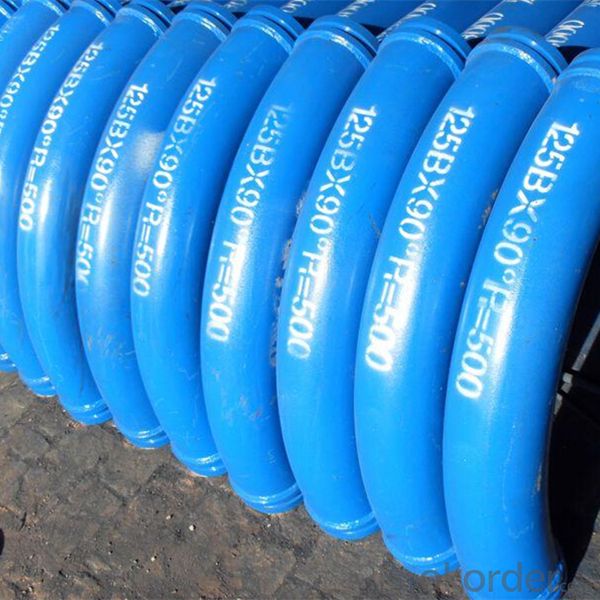
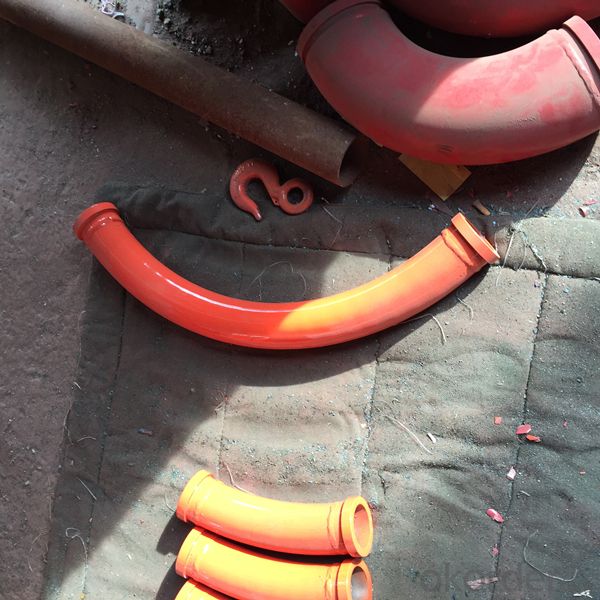
4. Concrete Pump Spare Parts Delivery Bend 45 Degree Specification:
Name | Concrete pump clamp coupling/elbow/pipe/spare parts/gasket |
Standard | Schwing, Putzmeister, Kyokuto, Cifa, Sany, Zoomlion. |
Type | 90O, 60O, 45O,11.5O DN125 {5”}--DN150(6") |
Radius | R275, R180 R320 |
Material | Hi-Mn13,ST52(16Mn), 45Mn2,45#steel and so on |
Usage | Used in Concrete Pump outlet in Construction Work Fit to Schwing and PM, Sany, Zoomlion, Cifa etc.), which include delivery pipe, elbow, reducer, coupling(clamp), male and female flange, rubber hose, cleaning ball, wear plate etc. Welcome to contact us for more information. |
finish | Painting, Epoxy or Galvanization |
Package | Wooden boxes |
5. FAQ:
We have organized several common questions for our clients, may help you sincerely:
①Is your products exported a lot?
We have exported to many, many countries. Every year we ship more than 30 containers of these spare parts. Our main market is in Middle-east, Asia & Africa.
②How to guarantee the quality of the products?
We have established the international advanced quality management system,every link from raw material to final product we have strict quality test;We resolutely put an end to unqualified products flowing into the market. At the same time, we will provide necessary follow-up service assurance.
③How long can we receive the product after purchase?
In the purchase of product within three working days, we will arrange the factory delivery as soon as possible. The specific time of receiving is related to the state and position of customers. Commonly 15 working days can be served.
- Q: What kind of concrete pump truck?
- At present, I know the pump mainly has the arm pump. This kind of arm work is flexible. Relatively fast speed. But the cost of maintenance and use is relatively high. Height limit. There are many requirements for the site
- Q: What is the function of a concrete pump hopper grate lever?
- The function of a concrete pump hopper grate lever is to control the opening and closing of the hopper grate on a concrete pump. The hopper grate is a metal grid that covers the hopper, which is the chamber where the concrete is loaded before being pumped. The lever allows the operator to easily manipulate the position of the grate, either opening it to allow concrete to flow into the hopper or closing it to prevent any debris or foreign objects from entering the pump system. This control is crucial for ensuring the smooth and efficient operation of the concrete pump, as any obstructions or contaminants in the hopper can potentially damage the pump or affect the quality of the pumped concrete. By using the hopper grate lever, the operator can maintain a steady flow of concrete into the pump and ensure that only clean and properly mixed concrete is being used. Additionally, the lever provides a safety measure, as it allows the operator to quickly close the grate in case of any emergencies or malfunctions. Overall, the concrete pump hopper grate lever plays a vital role in the proper functioning and maintenance of a concrete pump system.
- Q: Are there any specific guidelines for the installation of pipe or hose assemblies in concrete pump spare parts?
- Yes, there are specific guidelines for the installation of pipe or hose assemblies in concrete pump spare parts. These guidelines ensure proper installation techniques are followed to ensure the assemblies are securely and correctly installed. It is important to consult the manufacturer's instructions and adhere to industry standards to ensure optimal performance and safety of the concrete pump spare parts.
- Q: What are the common signs of wear and tear on concrete pump spare parts?
- The common signs of wear and tear on concrete pump spare parts can vary depending on the specific part in question. However, there are some general signs that can indicate when a concrete pump spare part is experiencing wear and tear. One common sign is visible damage or deterioration on the surface of the part. This can include cracks, chips, or dents on the outer layer of the spare part. These damages can occur due to regular use, exposure to harsh environmental conditions, or accidental impact during operation. Another sign is increased vibration or noise during operation. If a concrete pump spare part is experiencing wear and tear, it may start to produce unusual vibrations or noises that were not present when it was in good condition. This can be an indicator of internal damage or misalignment of the part, which can affect its overall performance and efficiency. Reduced performance or efficiency is also a common sign of wear and tear on concrete pump spare parts. If a part is experiencing wear and tear, it may not function as effectively as before, resulting in decreased pumping capacity, reduced flow rate, or inefficient operation. This can lead to delays in construction projects and increased maintenance costs. Additionally, increased maintenance and repair requirements can indicate wear and tear on concrete pump spare parts. If a part needs to be repaired or replaced more frequently than usual, it could be a sign that it is experiencing wear and tear. Regular inspections and maintenance can help identify potential issues early on and prevent further damage to the spare parts. In conclusion, signs of wear and tear on concrete pump spare parts can include visible damage, increased vibration or noise during operation, reduced performance or efficiency, and increased maintenance requirements. It is important to regularly inspect and maintain these spare parts to ensure their optimal performance and prolong their lifespan.
- Q: Are there any specific cleaning procedures for concrete pump spare parts?
- Yes, there are specific cleaning procedures for concrete pump spare parts. It is important to ensure that these parts are clean and free from any dirt or debris to maintain their efficiency and longevity. Here are some general guidelines to follow when cleaning concrete pump spare parts: 1. Safety First: Before starting the cleaning process, make sure to wear appropriate personal protective equipment (PPE) such as gloves and safety goggles to protect yourself from any potential hazards. 2. Disconnect Power: Before cleaning any electrical or mechanical parts, make sure to disconnect the power supply to avoid any accidents. 3. Remove Excess Dirt: Use a brush or a dry cloth to remove any loose dirt or debris from the surface of the spare parts. This will make the cleaning process more effective. 4. Use Appropriate Cleaning Solution: Depending on the type of spare parts and the level of dirt, choose an appropriate cleaning solution. Mild detergents or soapy water are generally safe to use. Avoid using harsh chemicals or solvents that may damage the parts. 5. Scrub and Rinse: Dip a clean cloth or sponge into the cleaning solution and gently scrub the spare parts to remove any stubborn dirt or stains. Rinse the parts thoroughly with clean water to remove any residue of the cleaning solution. 6. Dry Completely: After rinsing, make sure to dry the spare parts thoroughly using a clean cloth or by air-drying. Moisture can lead to rust or corrosion, so it is important to ensure complete drying. 7. Lubricate Moving Parts: If the spare parts have any moving components, such as bearings or gears, apply an appropriate lubricant to ensure smooth operation. This will help prevent wear and tear and extend the lifespan of the parts. 8. Regular Maintenance: To keep the concrete pump spare parts in optimal condition, it is recommended to perform regular cleaning and maintenance. Inspect them periodically for any signs of damage or wear and replace them if necessary. By following these specific cleaning procedures, you can effectively clean and maintain the concrete pump spare parts, ensuring their reliability and longevity.
- Q: How can a malfunctioning control box affect the pump's operation?
- A malfunctioning control box can disrupt the pump's operation in several ways. It may fail to send accurate signals to the pump, leading to incorrect speed or pressure settings. This can result in inadequate water flow or excessive pressure, affecting the pump's efficiency and potentially causing damage. Moreover, a malfunctioning control box might also cause the pump to start or stop unexpectedly, leading to inconsistent operation and potential system failures.
- Q: Why would the plugging concrete pump pipe
- When pumping, the operator shall observe the leftover material in the hopper at any time. The remaining material shall not be lower than the stirring shaft. If there is too little material, the air will be easily inhaled, which will lead to pipe blockage. The material in the hopper can not be piled too much, should be lower than the guard bar, so as to clean up the coarse aggregate and super large aggregate in time
- Q: What is the function of a concrete pump hydraulic motor?
- The concrete pump hydraulic motor serves the purpose of supplying the essential power and force needed for the operation of the concrete pump. Its responsibility lies in transforming hydraulic energy into mechanical energy, thereby enabling the pump to function with efficiency and effectiveness. By propelling the pumping mechanism, it allows the concrete to be transported through the pipeline and delivered to the desired destination. Additionally, the hydraulic motor governs the pump's speed and direction, facilitating accurate placement of the concrete. In conclusion, the concrete pump hydraulic motor plays a vital role in guaranteeing the seamless operation and triumphant delivery of concrete in construction endeavors.
- Q: Can concrete pump spare parts be customized with branding or logos?
- Yes, concrete pump spare parts can be customized with branding or logos. Many manufacturers and suppliers offer the option to customize spare parts with branding or logos according to the specific requirements of the customer. This customization can include adding logos, names, or specific branding elements onto the spare parts. It not only enhances the aesthetic appeal of the spare parts but also helps in promoting the brand or company. Customized branding or logos on concrete pump spare parts can also serve as a form of identification and help in distinguishing the parts from others in case of repair or replacement needs.
- Q: How often should concrete pump remote control batteries be replaced?
- The replacement of concrete pump remote control batteries relies on several factors, including frequency of usage, battery quality, and environmental conditions. However, as a general rule, it is advisable to change the batteries every 6 to 12 months. This guarantees optimal functioning of the remote control and prevents unforeseen battery failures during crucial operations. Additionally, it is crucial to periodically assess battery performance and perform maintenance checks to ensure proper functionality.
Send your message to us
Concrete Pump Spare Parts Delivery Bend 45 Degree
- Loading Port:
- Tianjin
- Payment Terms:
- TT OR LC
- Min Order Qty:
- 20 pc
- Supply Capability:
- 2000 pc/month
OKorder Service Pledge
OKorder Financial Service
Similar products
Hot products
Hot Searches
Related keywords
